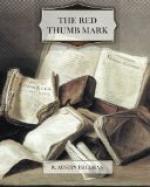As to Sir Hector Trumpler, that luminary of British jurisprudence was evidently completely fogged; for, as statement followed statement, he pursed up his lips and his broad, red face became overshadowed by an expression of utter bewilderment.
For a few seconds he stared blankly at his witness and then dropped on to his seat with a thump that shook the court.
“You have no doubt,” said Anstey, “as to the correctness of your conclusions? For instance, you are quite sure that the prints one and two are forgeries?”
“I have no doubt.”
“You swear that those two prints are forgeries?”
Mr. Singleton hesitated for a moment. He had been watching the judge and the jury and had apparently misinterpreted their surprise, assuming it to be due to his own remarkable powers of discrimination; and his confidence had revived accordingly.
“Yes,” he answered; “I swear that they are forgeries.”
Anstey sat down, and Mr. Singleton, having passed his notes up to the judge, retired from the box, giving place to his colleague.
Mr. Nash, who had listened with manifest satisfaction to the evidence, stepped into the box with all his original confidence restored. His selection of the true and the false thumb-prints was practically identical with that of Mr. Singleton, and his knowledge of this fact led him to state his conclusions with an air that was authoritative and even dogmatic.
“I am quite satisfied of the correctness of my statements,” he said, in reply to Anstey’s question, “and I am prepared to swear, and do swear, that those thumb-prints which I have stated to be forgeries, are forgeries, and that their detection presents no difficulty to an observer who has an expert acquaintance with finger-prints.”
“There is one question that I should like to ask,” said the judge, when the expert had left the box and Thorndyke had re-entered it to continue his evidence. “The conclusions of the expert witnesses—manifestly bona fide conclusions, arrived at by individual judgement, without collusion or comparison of results—are practically identical. They are virtually in complete agreement. Now, the strange thing is this: their conclusions are wrong in every instance” (here I nearly laughed aloud, for, as I glanced at the two experts, the expression of smug satisfaction on their countenances changed with lightning rapidity to a ludicrous spasm of consternation); “not sometimes wrong and sometimes right, as would have been the case if they had made mere guesses, but wrong every time. When they are quite certain, they are quite wrong; and when they are doubtful, they incline to the wrong conclusion. This is a very strange coincidence, Dr. Thorndyke. Can you explain it?”
Thorndyke’s face, which throughout the proceedings had been as expressionless as that of a wooden figurehead, now relaxed into a dry smile.
“I think I can, my lord,” he replied. “The object of a forger in executing a forgery is to produce deception on those who shall examine the forgery.”




